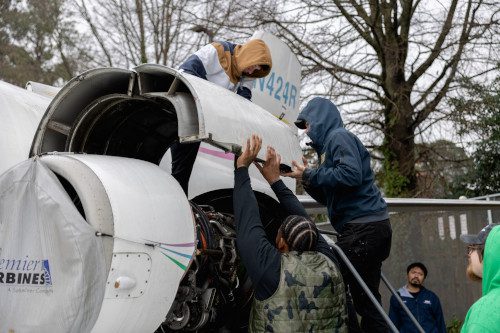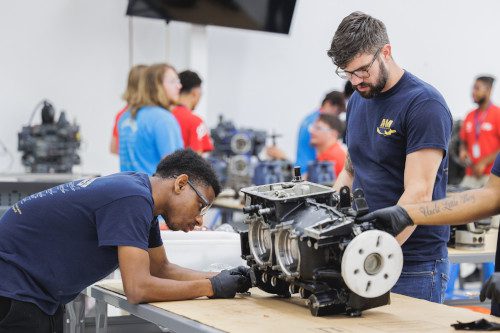In aviation maintenance school, one of the most common terms is A&P. But what exactly does it stand for and how does it provide the criteria needed to become an aviation maintenance technician? In this blog post, we’ll explore the term and how it can be used to pursue a career in aircraft maintenance.
Why an A&P is Essential to Aviation Maintenance
A&P stands for Airframe and Powerplant mechanic, also known as Aviation Maintenance Technicians, or AMTs. While the Federal Aviation Administration (FAA) can issue a single certificate with an Airframe (A) rating or a Powerplant (P) rating, the A&P certificate allows a person to work on both the external and internal parts of the aircraft. This includes any part of the engines and the auxiliary power sections such as the fuselage (body), empennage (tail) and the auxiliary power system, following FAA regulations.
Training to Earn an A&P Certificate

To become an aviation maintenance technician, students must receive the proper training and pass all of three of their required exams. At an aviation maintenance school, a tailored curriculum will teach and ready students for their career as an aircraft mechanic or aviation maintenance technician. Through hands-on, practical experience in the field of aviation maintenance technology, students will prepare for their FAA Oral and Practical exam, the last step prior to obtaining their A&P license. These certificate programs generally last close to two years for a full-time student.
Learning the Skills Needed to Become a Maintenance Officer
Students seeking to earn their A&P certificate at a school like the Aviation Institute of Maintenance will receive knowledge and experience in a diverse set of skills. Classes are divided into various parts of the plane so that students will understand each inside and out.
Types of Classes for an A&P Program
- Aircraft electrical systems
- Navigation systems
- Instrument systems
- Sheet metal repair
- Composite repair
- Hydraulic & pneumatic systems
- Lubrication & cooling systems
- Non-destructive testing
- Ignition & starting
- Induction & exhaust

These classes provide the procedures, practices, materials and tools that are needed to adhere to federal aviation regulations.
It Takes Hard Work
“Hard work and dedication are each needed throughout the training to become an aircraft mechanic,” said Theodore Cooper, the Director of Education at the Aviation Institute of Maintenance in Philadelphia. “However, in the end, the student will have opened the doors for an unimaginable amount of opportunity and will have obtained a multitude of experience requirements and satisfaction.”
Preparing for Exams
After learning the curriculum, students will then be eligible to take their A&P written exams. First comes the general exam followed by the airframe (A) exam and then the powerplant (P) exam.
The last step for a student will be to take their oral and practical exam where a designated mechanical examiner, also known as a DME, will sign off on those who pass. The FAA will then issue the aircraft mechanic their license in the mail with an assigned number. This marks the final step after a student receives their graduation certificate.
Typical Experience Requirements
Following graduation, on the job training (OJT) is a critical part of the process to becoming an Airframe and Powerplant technician. Typically, before a certified technician is sent off to perform maintenance, he or she must demonstrate knowledge and have performed the job at least once with someone is already trained in the same specific task.
This person generally serves as the trainee’s mentor. This type of training involves working with machine tools on various parts of the aircraft including fuel systems, turbine engines, and more.
Career Prospects in Aviation Maintenance

An A&P mechanic is eligible to apply for any position related to aviation such as those found within large commercial airlines, charter airlines, private airlines as well as overhaul and manufacturing operations.
Alternatively, an aviation maintenance technician can also work in an entirely different vicinity. In fact, the skills obtained with a mechanic certificate can also be used to maintain rides and attractions at amusement parks. With the basic systems of the mechanisms and equipment generally related to that of aircraft, amusement parks look forward to hiring people with their A&P certification.
The Future of Aviation Maintenance
With their A&P certification, an aviation maintenance technician offers a variety of skills which are needed to maintain performance and safety in today’s modern world of aviation. An A&P license is referenced as one of the highest standards that a mechanic can hold, not just in the United States but worldwide. With a short supply and continued high demand for A&Ps, anyone with a license who wishes to obtain a job should find success.
“A career as an A&P mechanic is a fulfilling and rewarding one,” said Cooper. “The decision to enroll in an A&P school was probably the smartest decision I’ve made in my life including the many challenges and rewards along the way.”
